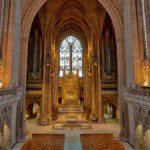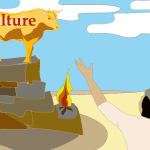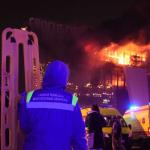The Bible’s chapter breaks are often misleading. They can be worse. The chapter break between Revelation 11-12 obscures the scene almost completely. Unless we know where this takes place, we don’t know what’s taking place.
At the end of chapter 11, the heavenly temple of God is opened , revealing the ark of the covenant (v. 19). We’re in the heavenly original of the Most Holy Place. Immediately, a great sign appears in heaven, a woman in labor, then another sign, a dragon (12:1-3).
Without the chapter break, our immediate question would be, What is a woman doing in the sanctuary before the ark? And then, What’s a dragon doing there?
Once we get rid of the distracting break and set the scene, a few things pop into place. First, we realize that the woman is dressed like a priest, with his brilliant solar robe and his golden crown. He doesn’t wear twelve stars on his head, but he does wear them over his heart, the twelve gem-stars of the tribes of Israel. Represented by the priest in the sanctuary, Mother Israel is the queen of heaven.
Then we realize that we’ve seen this scene before: Zechariah 3. Most Holy Place, check; dragon/Satan, check; woman/priest, check. This is a replay of Satan’s assault on the defiled high priest Joshua. There Satan wants to accuse and expel the priest from the Lord’s presence; here, the paedophage dragon is hungry, ready to devour the child.
In the event, the dragon does succeed in getting the woman out of heaven. But that doesn’t seem to matter. Apparently, the woman-priest’s work is done as soon as she gives birth. Besides, it’s not an improvement for the dragon, because her Son rises to the throne while Michael chases the dragon from the sky.
And then we can surmise this: This is a portrait of Israel’s history from Abraham on (there are allusions to both Hagar and the exodus in Revelation 12). Yahweh chose Israel to be Queen, and mother to His Son, and her whole history is a history of labor in the presence of God, labor before the ark-throne of the Creator, always threatened by a devouring dragon. This is Israel’s priestly, maternal calling, and, even after the woman leaves heaven, the labor to form Christ within the Christian communities continues in the work of Paul and the other apostles (cf. Galatians 4:19).














